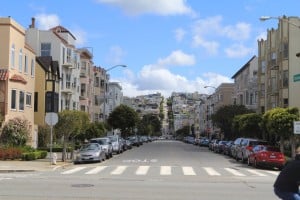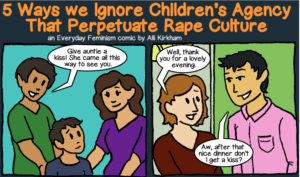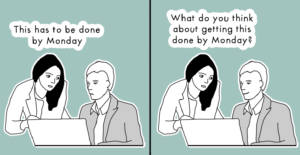
Source: Panoramio
There was once a small brick barbeque joint on Divisadero Street in San Francisco known as Da’ Pitt.
Its customer base was small, but loyal, comprised mostly of low-income African-American families. Though no one travelled more than walking distance to get there, nor wrote about it on Urbanspoon, it fed its community and it was loved.
But the neighborhood gentrified, the community dwindled, and Da’Pitt could no longer serve enough BBQ to pay its rent.
Another company, 4505 Meats, took over the space.
They put wood tables outside and painted the exterior. They added a vegetarian sandwich, an organic salad, and beers on tap to the menu. They hired young, bearded, and beanied white men to work the cash register. They put up artsy meat references, such as buffalo skulls and decorative metal pigs. They advertised the existing wood-fired barbeque pit as “historic.”
The building is the same, the barbeque is—well—still barbeque, but lines of yuppies and hipsters now extend down the block, and local food blogs are singing its praises.
Art-ified and White-ified, Da’Pitt is now Da’ Place to be.
And so is the rest of the block.
What used to be dollar stores and auto shops is an impressive collection of fine dining restaurants, high-end retail stores, specialty food vendors, and recently remodeled apartments that cost an average of $3,480/month (no, that’s not a typo).
The city’s “deadliest neighborhood” in 2005 became its “comeback neighborhood” in 2011.
What We Need to Talk About When We Talk About Gentrification
We know gentrification is racist and classist, that it hurts marginalized people and destroys communities. We know that it fits into a larger cultural reality in which people with more social, political, and economic power have more control over space. We know it fosters discrimination and cultural appropriation. We see the connections.
But there’s a reason that Divisadero Street comes to mind when I think about gentrification: because it’s not a clear picture of behemoth corporations and soulless developers snatching real estate from impoverished communities while comically evil landlords evict their tenants into surefire, immediate homelessness and politicians throw money in the air, laughing maniacally.
At least, that’s not what we see.
Instead, despite our negative views of gentrification, what many of us experience is a more subtle, nuanced version of gentrification, in which not every change is bad and there aren’t any obvious heroes or villains (pay no attention to that man behind the curtain!).
The owners of 4505 Meats, for example, are local residents who are known for using the whole animal, sourcing humane meat from local farmers, and other sustainable, community-oriented practices. They seem like good people, and if Yelp is any indication, their food is pretty good, too (their vegetarian sandwich has green chiles, Oaxacan cheese, and grits, y’all, and I want it).
And we feel more comfortable walking in their now well-lit parking lot.
And we miss our favorite dollar store down the street, but it’s gonna be a kava lounge, dude! (I don’t make this stuff up.)
We are those that benefit from gentrification. And we are ambivalent.
We laugh when things are sold as “urban” and “local” (like, what were they before?), but if we want them, and can afford them, we buy them. We cringe at the idea of sacrificing a one-dollar street taco for a six-dollar street-inspired taco, but if our friends invite us out to try one, we go. We side-eye the ten-dollar pear cocktail at the art bar, but what else are you to drink at Indie dance night?
And with our faces in our iPhones and our booties shaking to music made before our time that’s totally cool again, we forget that there is even a problem at all.
And it’s especially easy to ignore the struggles of the poorest members of our community when they have been removed from our community, when marginalized people are literally on the margins.
But just because something doesn’t look like a problem doesn’t mean it’s not a problem. So we can choose to enjoy the colorful, “revitalized” façade of our shiny new neighborhoods – or we can peek behind the curtain.
What Gentrification Really Is
Gentrification is not merely a natural shift in the demographics and business landscape of an area, but a collection of systematic changes to maximize profit, serving a higher class of people while alienating the middle class and pushing out lower income individuals and families.
The word gentrification comes from “gentry,” which denotes a noble, ruling class of people who own large tracts of land, to which they believe they are entitled, where other lesser people are not.
It’s the same idea that fueled European colonizers to roll up on this continent looking to occupy already-occupied land behind the enlightened, civilized doctrine of “me want, me take.”
It shouldn’t guide city landscapes in 2014.
But it does.
And the results are horrific.
Like immigrant families living twelve-to-a room in mold-ridden apartments, afraid to assert their tenant rights for fear of eviction. Or non-profit agencies unable to retain their funding as their once populous client bases are forced out of the city and far from the services they need to survive. Or meager earners attending apartment viewings where young white men in dress shirts walk in and write checks for double the asking move-in amount, pricing out everyone at the open house.
I want to scream and throw things do something about it.
Change Starts with Us
Challenging your privilege sucks, and it’s easy to find a reason to resist.
I just got here! I didn’t make this building or set this rent! I work hard at my job! I took the apartment I could afford! I’ve been dreaming of opening this restaurant my whole life! I charge six dollars for gluten-free donuts because people pay it!
Yes, you’re right. You’re not single-handedly responsible for all the problems in your city, and if you’re not a speculator or a landlord or a millionaire, you’re probably also limited by gentrification in some way. But your actions have consequences, and they don’t exist outside of the larger social context.
So, when you’re sitting on the balcony of your new high-rise flat eating your six-dollar vegan donut, watching the community below you crumble, you must ask yourself: Do I have a part in this? How do my actions affect this community? Is there something I can do with my power, privilege, and —ahem— money?
And yeah, there is.
1. Acknowledge Your Privilege
Privilege is a complicated issue, and no one is definitively “privileged” or “oppressed.”
But if you are able to live somewhere post-gentrification, are able to enjoy the amenities in a gentrified neighborhood, and aren’t somebody that people want out of their neighborhood due to some aspect of your physical presentation or identity, then you have some privilege that others don’t.
Own it. And use it to engender change.
Like, if you’re chillin’ at your start-up and your broworker is bragging about how he kicked a bunch of Latino teenagers off of their neighborhood soccer field because he paid the city to rent the field (seriously, I don’t make this stuff up), put down your craft brew, hop on the slide down to the first floor, and be like, “Not cool, bro!” He may hear your voice over those of a hundred local kids.
Yes, that likelihood is maddening.
But that’s the thing about power: It’s powerful.
2. Respect the History of Your New Neighborhood
Neighborhoods have a history, a people, a unique culture.
Enjoy it, learn about it, and work to preserve it, even as new cultural elements and businesses are introduced.
Don’t expect it to look like your old neighborhood.
3. Listen to the Voices of Your Neighbors
People like to talk about being a “voice for the oppressed.” That’s misguided. The oppressed have their own voices. We just have to hear them.
In February, Spike Lee criticized gentrification in the Fort Greene neighborhood of Brooklyn, NY, where he grew up.
When he was a child, Lee recounted, “The garbage wasn’t picked up every [expletive] day…the police weren’t around… why does it take an influx of white New Yorkers for the facilities to get better…to get the schools better?”
Lee’s impassioned speech was met with vicious criticism. Apparently, Lee had “mouthed off” and should “take a valium and calm down.”
Don’t dismiss the voices of marginalized people of color according to your genteel preferences. Open your mind. Truths aren’t always spoken calmly.
4. Understand That Residents Have Feelings About Their Changing Neighborhood
If there is anger, there’s a reason.
People who have been disadvantaged by gentrification may not be friendly or nice to you if your presence represents the destruction of their neighborhood – the very destruction that you benefit from.
Be sensitive to this, and allow for some discomfort.
Your discomfort is nothing compared to a disenfranchised group’s oppressed experience.
5. Make Socially Conscious Purchase Decisions
When you go out for a coffee or a drink or a sandwich, think about the places you are going to.
Are they welcome spaces for all types of people? Do they fit into the social landscape of the existing community? Do they hire local bartenders and waiters? Are they paid a living wage? Are there at least a few items on the menu that most people in the area could afford?
It doesn’t always matter that these places aren’t new – there’s always room for creativity and innovation – but that they add to the character of the neighborhood and don’t take away from it.
6. Invest in Community-Focused, Community-Run Organizations
Developers and large businesses love to create charities and fundraising projects to minimize (read: distract us from) the damage they are doing to a community. These projects are, however, often run by people from the organization (read: not the community).
If you want to invest your money or time into a community (yes! do!), make sure you are giving directly to the community and following their lead.
Communities know who they are, how they do things, and what they need better than outside bodies. And they should have the agency to direct these efforts towards change.
7. Question Exclusionary Tactics Claiming to Be About ‘Safety’
You may be told that the influx of bouncers, security guards, and police in your area is about keeping everyone safe.
Be skeptical.
Because this isn’t about the safety of everyone.
Security staff keep paying customers safe while making elite spaces unwelcome to anyone who doesn’t look like they fit in. Ask a teen in a hoodie if they feel safe in front of a nice restaurant or with increased law enforcement presence in the area and you might get a very different perspective.
Most importantly, despite claims that revitalization lowers crime, studies have suggested that gentrification actually increases crime. So, there’s that.
8. Advocate for Yourself and Others
Get to know the tenant rights laws in your area – they may be more comprehensive than you realize – and visit local organizations for additional information.
Share materials with others. Stand with your neighbors if they are facing eviction or being taken advantage of, and do the same for yourself.
When my last landlord attempted exploitative and illegal actions, ones he had carried out successfully with a string of young female tenants before us, we reported him immediately to the Rent Board. We won several hundred dollars, a signed agreement to stop, and the upper hand. We moved nearly a year ago, and he has yet to re-rent the place.
These victories matter.
9. Vote
This may be the most important factor of all.
Your vote can determine how rent control is regulated, how much affordable housing is built, whether a large corporation can build a skyscraper on your cityscape, what social services will be available this year, and other things that affect your area.
So, get out to the polls! No dress code required.
***
It’s easy to become overwhelmed by the reality of gentrification, but if you’re able to afford your apartment and your groceries, it’s also easy to ignore.
This isn’t about blame or guilt, but a call to make choices more in line with our values and visions of the world while maintaining respect for the visions that community members have for their own communities.
Unfortunately, not everyone will hear this call to action. They will shut their curtains, lock their doors, and call the cops if it gets too loud.
And that’s Da’ Pitts.
[do_widget id=”text-101″]
Katy Kreitler is a Clinical Social Worker specializing in youth, gender, and trauma. She holds an MSW from USC and a BA in Psychology and Sociology from USF. She can be found somewhere in San Francisco reading a book, eating a burrito, and side-eyeing humanity.
Search our 3000+ articles!
Read our articles about:
Our online racial justice training
Used by hundreds of universities, non-profits, and businesses.
Click to learn more



















